Day Four — Nyala Bull!
My notes read…we sat in the mamba blind yesterday from 11:30 to 6:30. I saw the familiar ostrich and had my first encounter with baboons. I noted with interest that baboons and monkeys were by far the most cautious animals around the waterhole. They approached the water with the wind in their face, yet drank from the upwind side of the water with the wind at their back. Apparently it allowed them to smell an intruder approaching from behind while watching for predators downwind — very smart.
As the sun dipped behind the trees, a mature duiker approached the water. I was tense with bow in hand, hoping to get a fading-light shot. Dick, who had joined Pete and me to film the hunt, pointed to the right side of the blind with an excited expression on his face. I incorrectly assumed he saw the duiker. I placed my release on the string loop and anticipated the shot. Pete whispered, “Nyala, and it’s a good one.” To be honest, I hardly knew what a nyala looked like, but I was ready to shoot after hunting for almost eight hours without action!
I was overwhelmed at how huge the bull nyala looked as he walked into view from behind the blind. He was tall and long-legged with a thick, dark mane. It all happened quickly. He quartered to me with his front leg back. I didn’t like this shot and held steady at full draw. Luckily, he didn’t stop long to drink and moved to the other side of the water, where he squared-up broadside. Still at full draw, I placed the top pin squarely on his shoulder muscle, released the arrow and watched it hit exactly where I had aimed. With wild intensity he exploded into a panicked run through the water. I glanced at Dick, who pumped his arm and said “good shot.” Through binoculars I watched as the bull crashed head over heels within 70 yards.
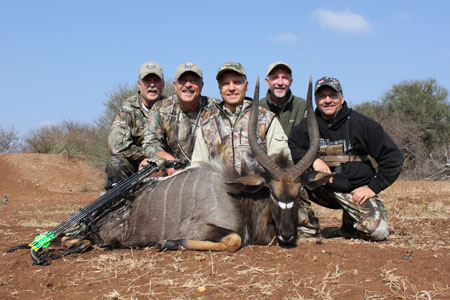 Shot placement tip: In the months leading up to the hunt, the importance of proper shot placement became evident. I talked with several people who had hunted Africa, and they explained how the vitals on African animals are farther forward than the typical North American whitetail. My outfitter confirmed this and said “you will want to shoot your animals in the shoulder.”
Shot placement tip: In the months leading up to the hunt, the importance of proper shot placement became evident. I talked with several people who had hunted Africa, and they explained how the vitals on African animals are farther forward than the typical North American whitetail. My outfitter confirmed this and said “you will want to shoot your animals in the shoulder.”
In order to help me further, he recommended a book called “The Perfect Shot,” which gives a nice synopsis of each animal and clearly illustrates perfect shot placement. The guide illustrates each animal with two photo images. The first image shows the animal as you would see it in the field, while the second image overlays the bone structure and vital area, making it easy to see the proper shot placement. “The Perfect Shot” has two other resources available for purchase: A video that shows shot placement while highlighting actual hunts, and paper targets with the images of African animals. The target is unique in that one side has an image of the animal and the other side overlays the bone structure and vital area, allowing you to see where your arrow hit the vitals.
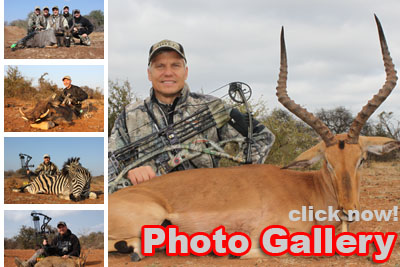 |
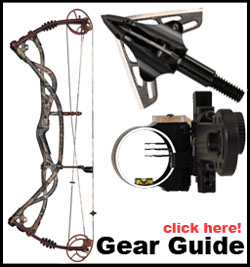 |
Check out the rest of Part 2 by clicking on the pages below. Part 1 is HERE.
As a convenience and to best help United States clients, Jurie Meyer has asked Dick Scorzafava to be his U.S. representative and to answer questions related to hunting with Jurie. Dick lives on the East Coast. He can be contacted at (413) 568-5604 or at scorzafava@aol.com. Jurie will be attending the Safari Club International show in Reno, Jan. 26-29 and the Eastern Sports & Outdoor Show in Harrisburg, Pa. on Feb. 5-13.
Day Five — Wildebeest
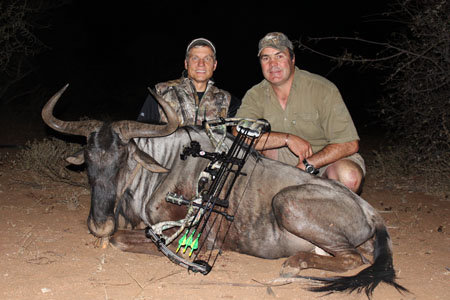 On Day Five I sat in the diesel blind. It was a slow day for game movement; mostly warthogs, baboons, guinea fowl and giraffe. But just like in whitetail hunting, some of the best African game movement happens as daylight is fading. This was the case with the blue wildebeest that I spotted at about 300 yards and approaching. Pete confirmed that it was a mature bull, but the animal took his time easing another 100 yards towards the blind before he hung up and would not come further. Eventually he moved into thick cover, where we lost sight of him.
On Day Five I sat in the diesel blind. It was a slow day for game movement; mostly warthogs, baboons, guinea fowl and giraffe. But just like in whitetail hunting, some of the best African game movement happens as daylight is fading. This was the case with the blue wildebeest that I spotted at about 300 yards and approaching. Pete confirmed that it was a mature bull, but the animal took his time easing another 100 yards towards the blind before he hung up and would not come further. Eventually he moved into thick cover, where we lost sight of him.
A half hour later, seven ram impala appeared in the distance. They cautiously approached and within ten minutes seemed to relax around the water. They seemed to be watching something in the direction where we had last seen the wildebeest, and I grabbed my bow. Sure enough, within a minute or two the wildebeest stepped into view 65 yards from the blind. There’s no question in my mind — he had waited until the impala had no fear of danger at the water before he approached. Now, without hesitation he walked in and began to feed. He faced us head-on for several minutes and Pete ranged him at 20 yards. My release was on my string loop and I took several deep breaths trying to calm myself.
Up to this point, Pete and I had remained relatively calm during the shot sequence of the other animals we had taken —with the exception of a gemsbok that had approached us a couple days before while we were in the baobab blind. I had almost laughed out loud when I realized how loud Pete and I had been breathing in our excitement! The opportunity never panned out for that gemsbok, but it now looked very promising for the wildebeest.
When the bull turned broadside, I settled the pin on his shoulder and released the arrow — thwack! I heard and saw the arrow hit and immediately wondered if it was high. The bull ran bucking and kicking, but to my concern, didn’t stop anytime soon. Pete was watching closely and agreed that the shot might have been a little high. Around 300 yards away the wildebeest finally slowed down to a walk just as he went out of sight. We talked through the shot sequence as we looked at the “Perfect Shot” field guide. Pete was very reassuring and said, “keep in mind that you are shooting down to him — that’s a dead wildebeest.”
Pete and I, along with the trackers and Dick, went immediately to the spot that we had last seen the bull. Darkness had fallen by now, so we were relying on flashlights. As the trackers looked for blood and tracks in the dirt, I cast my light in the distance and there he was, dead. What a tough animal — he ran 320 yards after being doubled-lunged with an arrow.
Wild Game Dinners: It’s fun to see the look on people’s faces when I tell them I ate zebra! Jurie sent a personal profile to each of us prior to the trip and in it asked if we had special needs or requests. One of my requests was to eat some of the game we shot. Each night we enjoyed a magnificent meal, usually cooked over the open coals of the fire pit. We ate blue wildebeest, gemsbok, kudu and zebra. Though all were very good and I enjoyed them as much if not more than a whitetail, it took us by surprise that all agreed zebra was the best-tasting animal we ate.
 |
 |
Check out the rest of Part 2 by clicking on the pages below. Part 1 is HERE.
As a convenience and to best help United States clients, Jurie Meyer has asked Dick Scorzafava to be his U.S. representative and to answer questions related to hunting with Jurie. Dick lives on the East Coast. He can be contacted at (413) 568-5604 or at scorzafava@aol.com. Jurie will be attending the Safari Club International show in Reno, Jan. 26-29 and the Eastern Sports & Outdoor Show in Harrisburg, Pa. on Feb. 5-13.
About That Zebra
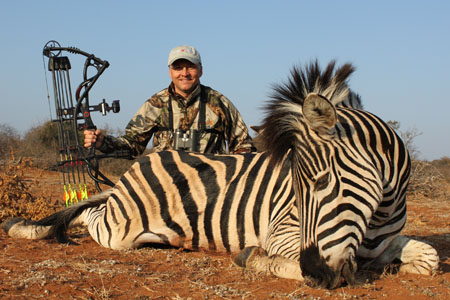 A year ago as I was beginning to plan this trip, I had several people ask questions ranging from the cost of the trip to the length of time I’d be away to the kind of animals I would hunt. Perhaps the most noteworthy discussion I had was with my wife and daughter — they are both horse enthusiasts and made it quite clear to me that they thought of a zebra as a horse and would be disappointed if I shot one. Feeling quite fortunate to have the support of my family in every other aspect of this trip, I gave them my word that I would not shoot one.
A year ago as I was beginning to plan this trip, I had several people ask questions ranging from the cost of the trip to the length of time I’d be away to the kind of animals I would hunt. Perhaps the most noteworthy discussion I had was with my wife and daughter — they are both horse enthusiasts and made it quite clear to me that they thought of a zebra as a horse and would be disappointed if I shot one. Feeling quite fortunate to have the support of my family in every other aspect of this trip, I gave them my word that I would not shoot one.
As it turns out, zebras are beautiful, wild animals that exude “Africa.” Making promises a year in advance and half a world away is one thing, but keeping the promise while your itchy trigger finger is just 20 yards from a trophy animal in Africa is quite another. I struggled with the commitment I had made not to shoot, but in the end I chose to honor the wishes of my wife and daughter rather than go against my word. Besides, a zebra was not on my hunt wish-list of animals I hoped to shoot.
Tip: On the subject of wish-lists: Dick told me that even though we had a prearranged hunt package, I’d want to remain flexible and consider shooting other game if an opportunity presented itself. Again, this is not a controlled hunt and we never knew what was going to come in to the blind. Dick warned that I might end up regretting a decision to pass on an animal if I was rigid about my package. My nyala is a good example of this recommendation. Jurie’s main concern was that we were fully happy with our hunt. He was very willing to work with us on changing animals if needed.
My plan is to return to Africa in 2012; I cannot wait! Jurie Meyer Safaris was excellent and I highly recommend his bowhunt for a variety of reasons.
• Planning and execution of the plan
• Attention to detail
• Accommodating service
• Trophy animals
• Excellent food and opportunity to eat our game
• Very comfortable accommodations
• Adventure, hunted two concessions, visited Kruger Park
• Friendship
 |
 |
Check out the rest of Part 2 by clicking on the pages below. Part 1 is HERE.
As a convenience and to best help United States clients, Jurie Meyer has asked Dick Scorzafava to be his U.S. representative and to answer questions related to hunting with Jurie. Dick lives on the East Coast. He can be contacted at (413) 568-5604 or at scorzafava@aol.com. Jurie will be attending the Safari Club International show in Reno, Jan. 26-29 and the Eastern Sports & Outdoor Show in Harrisburg, Pa. on Feb. 5-13.
Before You Go Hunting to Africa
Making Flight Arrangements
Our party opted to use a travel agent familiar with travel to Africa. We originated from different airports but connected through Atlanta and needed to arrive in Johannesburg at the same time to meet our outfitter. Our agent coordinated the connections and made it very convenient for us. Two people did online airfare research via the discount ticket providers but did not find a significant savings compared to the full-service travel agent. In addition, I opted for travel insurance that cost an extra $120.
Get Your Shots
I’d heard that there were a few disease-prevention shots required, so I visited my general practitioner to learn about shots. Based on the recommendation he found online from the U.S. Center for Disease Control, he administered a few of the vaccinations. Later, I discovered a travel clinic tailored specifically for international travelers. Turns out that the recommendation I received from the travel clinic (right or wrong) was more comprehensive than what my general practitioner provided. In the future I’ll use only the travel clinic. They also provided documentation of all the shots that I had received. This documentation is sometimes required for travel into some parts of Africa.
Gear Up: My Personal Gear
• Bow: Hoyt Carbon Matrix, 29 ½-inch draw length, 62-lb. draw
• Arrows: Easton Full Metal Jackets
• Arrow vanes: Bohning Blazers
• Broadheads: NAP two-blade Blood Runners
• Bow sight: Montana Black Gold Ascent
• Quiver: Tight Spot
• Camo: Scent-Lok clothing in Realtree AP; Sitka Gear; Hunter’s Specialties Tek4
• Scent products: Hunter’s Specialties Scent-A-Way, wafer cover scent and laundry detergent
• Bow case: SKB
Stay In Touch
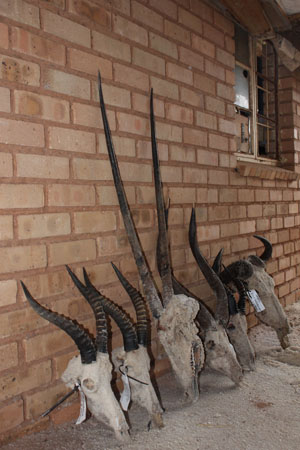
My pre-trip planning included a call to my cell phone service provider requesting international voice and data coverage. Surprisingly, on several occasions I was able to e-mail and call home while on the ranch.
Practice, Practice, Practice
I shot my bow nearly every day for three months in order to prepare for this hunt. Even if I released only two or three arrows, I practiced daily. The three of us killed 13 animals on this hunt and not one of them was lost. Jurie was very impressed with the high recovery rate. Don’t be lulled into a false sense of confidence knowing that most of your shots will be 25 yards or less. Become proficient shooting to 40 yards and beyond. Also, all of our blinds had mesh curtains covering the windows. We kept them closed except for a 6-inch vertical opening that we shot through. If at all possible, create something that simulates a 6-inch opening and practice shooting though it. And of course it will be helpful to practice shooting from an elevated tree stand or platform.
Plan For The Taxidermy
Taxidermy is a subject you’ll want to consider prior to your African safari. I was surprised that my usual taxidermist, who I’ve used for years, referred me to a guy that specializes in African animals. It never occurred to me that he would refer my work to another taxidermist. I visited the taxidermist and discussed different mount options and the estimated cost of each. We also talked about the process of clearing my animals through U.S. customs. He was knowable about the freight process and referred me to a shipping broker. It turns out that your outfitter will ship your animals to a U.S. broker. The broker then forwards the crate to your state customs department, where your customs-approved taxidermist picks them up. It sounds a little complex, but it’s really not. At least I don’t think it is — our crate has not arrived yet.
Many hunters leave their animals with the outfitter and have their mounts done by an African taxidermist. I assume that the process of freight and customs is similar, but don’t quote me on that. Outfitters do this all the time, so everyone is familiar with the process, but it’s worth giving it some thought before your trip.
 |
 |
Check out the rest of Part 2 by clicking on the pages below. Part 1 is HERE.
As a convenience and to best help United States clients, Jurie Meyer has asked Dick Scorzafava to be his U.S. representative and to answer questions related to hunting with Jurie. Dick lives on the East Coast. He can be contacted at (413) 568-5604 or at scorzafava@aol.com. Jurie will be attending the Safari Club International show in Reno, Jan. 26-29 and the Eastern Sports & Outdoor Show in Harrisburg, Pa. on Feb. 5-13.






